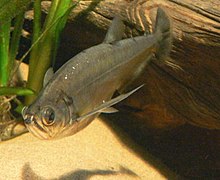
Characidae, the characids or characins, is a family of freshwater subtropical and tropical fish belonging to the order Characiformes. The name "characins" is a historical one, but scientists today tend to prefer "characids" to reflect their status as a, by and large, monophyletic group. To arrive there, this family has undergone much systematic and taxonomic change. Among those fishes remaining in the Characidae currently are the tetras, comprising the very similar genera Hemigrammus and Hyphessobrycon, as well as a few related forms, such as the cave and neon tetras. Fish of this family are important as food in several regions, and also constitute a large percentage of captive freshwater aquarium fish species.
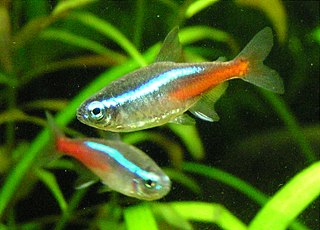
Paracheirodon is a genus of freshwater fish in the family Characidae of the order Characiformes. The type species is P. innesi, the well-known neon tetra, and the Paracheirodon species are among the fishes known as tetras. All species of this genus are native to the Neotropical realm, occurring in the Orinoco and Amazon Basins in northern South America.

The payara, Hydrolycus scomberoides, is a species of dogtooth tetra. This predatory fish is found in the Amazon Basin in tropical South America. It was the first of four species to be described in the genus Hydrolycus.
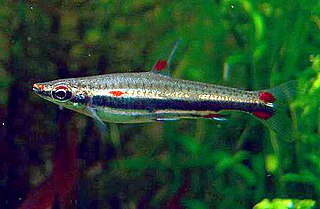
The pencil fishes are a family (Lebiasinidae) of freshwater fishes found in Costa Rica, Panama, and South America. They are usually small and are known as ornamental fishes in aquaria, including popular fishes such as the various pencil fish and the splashing tetra.
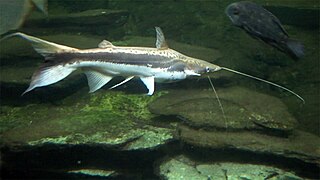
Sorubim is a small genus of long-whiskered catfish native to tropical South America. A number of characteristics allows the differentiation of each species in the genus. Sorubim species are important food fish in South America and are highly significant to fisheries of some areas; however, harvests of these fish are not identified as much as other, more popular food fishes such as Colossoma, Arapaima, and Brachyplatystoma. Some species of this family are popular aquarium fish.
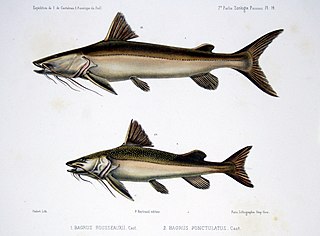
Brachyplatystoma is a genus of catfish from the family Pimelodidae. As the occasionally used common name goliath catfishes indicates, this genus includes some of the largest species of catfish, including the piraíba, B. filamentosum, which reaches up to the region of 3.6 metres (12 ft) in length. Brachyplatystoma are found in the Amazon and Orinoco basins, and other tropical freshwater and brackish habitats in South America. Some species are migratory. These fish are important as food fish and, to some extent, aquarium fish.

Cynodontinae is a subfamily of tropical and subtropical South American fishes of the family Cynodontidae. They are characterized by an oblique mouth and very long distinct canines, which are used to capture and stab their prey, other fish that can be up to half the length of the cynodontine itself. They are not prized as food fish, but are important in subsistence and commercial fisheries. Hydrolycus are game fish, having been recently added to the International Game Fish Association in the fly and rod class. Cynodontid fish are also sometimes housed in aquaria.

Steindachneridion is a genus of South American pimelodid catfish.

Pseudopimelodus is a genus of catfishes of the family Pseudopimelodidae.
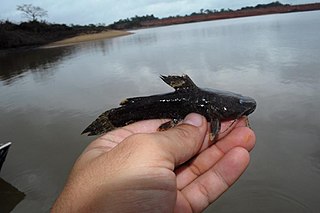
Batrochoglanis is a small genus of catfishes of the family Pseudopimelodidae.

Bagarius is an Asian genus of catfishes of the family Sisoridae. It includes five to six extant species and potentially one extinct fossil species, B. gigas.

Gagata is a genus of sisorid catfishes native to Asia.

Myloplus schomburgkii, also known as the Disk tetra, Disk pacu, Black-ear pacu, Black-band myleus or Black-barred myleus is a species of serrasalmid with a black bar on its side. This species is found in the middle and lower Amazon River basin, Nanay River, upper Orinoco River basin in Brazil, Peru, Venezuela and possibly in Suriname.

Hydrolycus is a genus of large dogtooth characins from tropical South America, where found in the Amazon and Orinoco basins, as well as rivers of the Guianas. The genus includes the largest dogtooth characins, reaching up to 1.17 m (3.8 ft) in length. They have long, pointed teeth used for spearing their prey, generally smaller fish. In a study of the stomachs of 45 individuals, most were empty, but among the remaining the prey fish were 15–50% of the length Hydrolycus itself.

Hydrolycus armatus is a species of dogtooth characin found in freshwater of tropical South America. It is sometimes known as Payara, or harm, a name it shares with the related H. scomberoides.

Hydrolycus tatauaia is a species of dogtooth characin found in the Amazon, Orinoco and Essequibo basins in tropical South America. Adults mainly occur in deep and/or fast-flowing rivers. It is migratory, moving upstream to breed in November–April.

Acnodon normani, the sheep-pacu, is a species of serrasalmids found in South America. It is found in the Amazon, the Xingu and Tocantins River basins in Brazil. This species reaches a length of 19.9 cm (7.8 in).
Acnodon senai is a species of serrasalmids found in South America. It is found in the Jari River basin in Brazil. This species reaches a length of 13.2 cm (5.2 in).

Hypostomus iheringii is a species of catfish in the family Loricariidae. It is native to South America, where it is occurs in the Paraná River drainage basin, being known from the Tietê River basin as well as the Corumbá River, where it is syntopic with Hypostomus ancistroides, H. denticulatus, H. heraldoi, H. margaritifer, and H. regani. The species reaches 11.6 cm in standard length and is believed to be a facultative air-breather.
